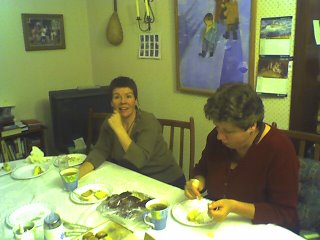Happy Thanksgiving!

I'm going to Guelph tonight to celebrate Thanksgiving with my family. This is our first holiday together as a family since my mother died and will be difficult to be there without having my mother prepare many of the special dishes. But a family potluck will have to do. The picture is of both my sisters - the one on the left, Dorothea, flew in from Halifax for the funeral and of course for Thanksgiving dinner!
For all my American friends out there who think it is a bit unusual for Thanksgiving to be celebrated in October so far from Christmas, just remember the holiday was first celebrated in Canada. Check out the following (found on the Christian Direction website).
The first and original Thanksgiving comes from Canada. The history of Thanksgiving in Canada goes back to an English explorer, Martin Frobisher, who had been trying to find a northern passage to the Orient. He did not succeed but he did establish a settlement in Northern America. In the year 1578, he held a formal ceremony, in what is now called Newfoundland, to give thanks for surviving the long journey. This is considered the first Canadian Thanksgiving. Other settlers arrived and continued these ceremonies. He was later knighted and had an inlet of the Atlantic Ocean in northern Canada named after him - Frobisher Bay. In Canada, Thanksgiving is celebrated on the second Monday in October. Unlike the American tradition of remembering Pilgrims and settling in the New World, Canadians give thanks for a successful harvest.
The first Thanksgiving Day in Canada after Confederation was observed on April 5, 1872 to celebrate the recovery of the Prince of Wales (later King Edward VII) from a serious illness. Before then, thanksgiving days were observed beginning in 1799 but did not occur every year. Starting in 1879 Thanksgiving Day was observed every year but the date was proclaimed annually and changed year to year. The theme of the Thanksgiving holiday also changed year to year to reflect an important event to be thankful for. In the early years it was for an abundant harvest and occasionally for a special anniversary. After the First World War it was for Armistice Day and more recently and including today it has been a day of general thanksgiving.
What has come down in American tradition as the "First Thanksgiving" was actually a harvest festival. In the spring of 1621, the colonists planted their first crops in Patuxet’s abandoned fields. While they had limited success with wheat and barley, their corn crop proved very successful, thanks to Squanto [Tisquantum] who taught them how to plant corn in hills, using fish as a fertilizer. In October of 1621, the Pilgrims celebrated their first harvest with feasting and games, as was the custom in England, as well as prayer. The celebration served to boost the morale of the 50 remaining colonists and also to impress their allies.
The Pilgrims would not have called the event of 1621 a "Thanksgiving." The Separatist Puritans recognized three kinds of holidays as sanctioned by the Bible : the Sabbath, days of thanksgiving, and fast days. Unlike the Sabbath, days of thanksgiving and fast days were not part of the established calendar. They were proclaimed by the governor only in response to a specific situation. A religious day of fasting could be invoked by a drought or war. A religious day of thanksgiving could be called to celebrate a particularly good harvest or providential rainfall.
After the American Revolution the first American national Thanksgiving Day, proclaimed by George Washington, was Nov. 26, 1789 - a one time event. Abraham Lincoln, urged by Sarah J. Hale, revived the custom in 1863, appointing as the date the last Thursday of November. At that time, Thanksgiving was not yet part of the national calendar. The governor of each state would determine when (or if) a Thanksgiving would be held. Thanksgiving did not become an annual national holiday until President Abraham Lincoln's 1863 proclamation. In 1939, 1940, and 1941 Franklin D. Roosevelt proclaimed Thanksgiving the third Thursday in November. When a contradiction arose between Roosevelt’s proclamation and some of those of state governors, Congress passed a joint resolution in 1941 decreeing that Thanksgiving should fall on the fourth Thursday of November.
The use of the turkey for Thanksgiving relates back to Lincoln's nationalization of the holiday in 1863 and not back to the Pilgrim celebration. Since a turkey could feed more than a chicken, those were sent to the troops instead as a more cost effective feast. The meat at the table would more likely have been duck or deer. Source: Mourt's Relation: A Journal of the Pilgrims at Plymouth (London, 1622), in a letter written by Edward Winslow: "Our harvest being gotten in, our governor sent four men on fowling, that so we might after a special manner rejoice together after we had gathered the fruits of our labors . . . many of the Indians coming amongst us, and among the rest their greatest king Massasoit, with some ninety men, whom for three days we entertained and feasted, and they went out and killed five deer, which they brought to the plantation and bestowed on our governor, and upon the captain [Myles Standish] and others."
Just thought you might be interested.
Happy Thanksgiving!
1 comment:
It's a great feeling to spend Thanksgiving with family. It's a day to remember all the great things of the past and be thankful for everything that we have in life. Visit this Thanksgiving Blog to find out more things to be thankful for on Thanksgiving.
Post a Comment